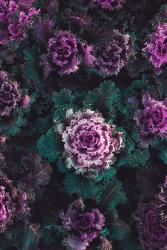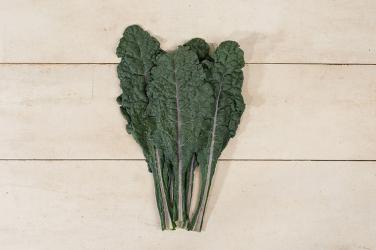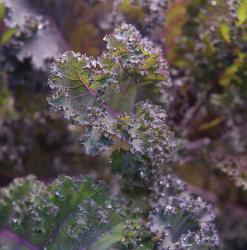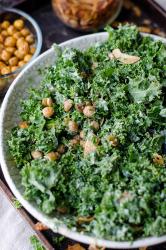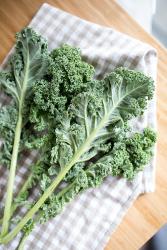What About It? Kale is often a controversial topic for avid green eaters and recent health-kickers alike; but, if you learn about the different varieties, taste profiles and preparation tactics, there is a perfect kale for everyone interested in adding it to their diet!
A cool-weather leafy green, kale isn’t just the latest trend—and it isn’t always green! In fact, it’s been cultivated for over 2,000 years for its high-nutritional content and hardiness through winter months that could keep a body running smoothly during the coldest months of the year. The past 2,000 years have bred new, tastier and more beautiful varieties of the healthful staple.
Four Main Types: When you think of kale, curly kale is probably what comes to mind. Known for their crinkled leaves and mild flavor, curly kale is simple to cook with and comes in a wide variety of colors from green to blue and even purple.
Lacinato Kale, or “Dinosaur” kale, has a completely different texture, often described as scaly. A Foodie favorite, the leaves are typically blue-green, and they tend to be vigorous and easily harvestable from spring through fall.
Flat leaf kales are the hardiest of breeds, usually grown as a fall crop or overwintering vegetable. Also known as Russian kale, the main flavor profiles in these types are much sweeter due to accumulation of sugar in their leaves after a frost.
Known as a beautiful addition to any autumn landscape, ornamental kale is popular for decoration, but not for consumption. If you’re just looking for some added fall color or an accent in a bouquet, ornamental kale is the way to go.
Choose Your Fighter
Black Magic Kale: The signature Lacinato-type, "Black Magic" has been a farmer staple for decades. It is a selection of the well-maintained Toscano kale line. This variety is known for its uniformity, dark bluish-green leaves and beautiful savoyed texture. The tall plants yield elongated, attractive leaves that bunch beautifully together. This variety is open-pollinated and available as a certified organic seed. It takes about 65 days to mature and can be harvested spring through winter. In zones 6 and warmer, this frost-tolerant cultivar can grow almost year-round. It has an earthy flavor that sweetens with frost.
Dazzling Blue: The bold purple midribs and blue-green flattened leaves of this Lacinato type stand out stupendously against the rest. "Dazzling Blue" is, well, dazzling! The plants grow very tall and fast, producing a nice variability in leaf shape and coloration. Bred in Oregon by Wild Garden Seed, this cultivar tastes as beautiful as it looks. It’s open-pollinated and takes around 60 days to reach full-sized leaf harvest.
Winterbor: A classic curly type, "Winterbor" is one of the most common commercially grown kales that you find in grocery stores. It has thick blue-green leaves that curl downward and deeply ruffle at the edges, creating ample volume and texture for delicious meals. With its winter hardiness and great early spring productivity, "Winterbor" is the standard curly kale for a reason. It yields excellently and tastes great. It is a vigorous plant, often growing 2-3 feet tall with continuous production of curled ruffly leaves. This cultivar takes about 60 days to mature.
Redbor: With vibrant purple-to-burgundy colored leaves, "Redbor" is an exciting and radiant addition to your garden. This red version of Winterbor has all the frost tolerance and frilly texture you love, plus deep anthocyanin-rich coloration. The flavor and color will intensify even more in colder weather, making this the perfect option for a color pop in fall and winter gardens. "Redbor" is delicious cooked or raw massaged with oil. This hybrid takes 55 days to harvest.
Red Russian: One of the hardiest varieties, the gorgeous purple stems and mineral-rich wide leaves of "Red Russian" make for a show-stopping winter garden display. This variety provides continuous harvests of flattened, oak-leaf-shaped leaves that keep growing back all season long. As one of the most mineral-rich and dense-textured cultivars, "Red Russian" is a classic heirloom veggie that is specially adapted to the extreme cold. It originated in Siberia and Russian traders first brought it to Canadian and American growers in the late 1800s. It matures to full size leaves in just 50 days.
Scarlet: Ultra-curly leaves add beauty and interest to the garden as well as the plate. This variety holds its reddish tint on top of a blue-green background color, whereas its cousin "Redbor" has a red coloration sprinkled atop a bright green leaf. Either way, the scarlet color intensifies with frosts. The plants aren’t as uniform as other types, but they are certainly vigorous and resilient. Averaging 2-3 feet tall with an upright growth habit, this curly red kale takes just 55 days to mature to its full leaf size. It’s also a great option for baby leaf production.


